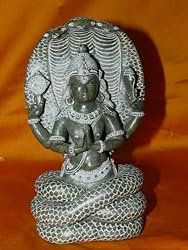The foundation of all later Schools of Yoga go back to Patanjali.The word Yoga automatically calls to mind Sage "Patanjali" the founder and father of Yoga Sutras.
Traditional depiction of Patanjali in meditation with four arms and his lower portion as the Ananta Sesa Cobra, representing the original source of all teachers & Gurus. His 2 rear hands hold the emblems of Vishnu, A Discus and Conch, while his front hands are in the Namaste or prayer postion, the Anjali Mudra. Patanjali, is the original author of the Yoga Sutras.
Traditional depiction of Patanjali in meditation with four arms and his lower portion as the Ananta Sesa Cobra, representing the original source of all teachers & Gurus. His 2 rear hands hold the emblems of Vishnu, A Discus and Conch, while his front hands are in the Namaste or prayer postion, the Anjali Mudra. Patanjali, is the original author of the Yoga Sutras.
 Patanjali's Yoga has essentially to do with the mind and its modifications. It deals with the training of the mind to achieve oneness with the Universe. Incidental to this objective are the acquisition of siddhis or powers.
Patanjali's Yoga has essentially to do with the mind and its modifications. It deals with the training of the mind to achieve oneness with the Universe. Incidental to this objective are the acquisition of siddhis or powers.Lord Patañjali is reckoned to be an incarnation of the serpent Ananta, whose name means 'the endless one' -- and who is another form of Adisesa. The Lord Vishnu sits upon Adisesa before the beginning of creation. Patañjali himself is generally depicted as half human and half serpent, with the human torso emerging from the coils of the all-powerful serpent who is awakening in the moment of creation. The serpent embodies that creative energy. Lord Patañjali's hands are in the traditional Indian greeting of 'namaste' -- sometimes called an 'añjali' or offering. Since 'pata' means fallen, 'Patanjali' can be roughly translated as 'the grace (or "the grace-full one") that falls from heaven'.
The aim of Patanjali Yoga is to set man free from the cage of matter. Mind is the highest form of matter and man freed from this dragnet of Chitta or Ahankara (mind or ego) becomes a pure being.
The mind or Chitta is said to operate at two levels-intellectual and emotional. Both these levels of operation must be removed and a dispassionate outlook replace them. Constant Vichara (enquiry) and Viveka (discrimination between the pleasant and the good) are the two means to slay the ego enmeshed in the intellect and emotions. Vairagya or dispassion is said to free one from the pain of opposites love and hate, pleasure and pain, honour and ignominy, happiness and sorrow.
The mind or Chitta is said to operate at two levels-intellectual and emotional. Both these levels of operation must be removed and a dispassionate outlook replace them. Constant Vichara (enquiry) and Viveka (discrimination between the pleasant and the good) are the two means to slay the ego enmeshed in the intellect and emotions. Vairagya or dispassion is said to free one from the pain of opposites love and hate, pleasure and pain, honour and ignominy, happiness and sorrow.
Concentration also calls for regulation of conduct if Bhakti must develop. Good cheer, compassion, absence of jealousy, complacence towards the virtuous and consideration towards the wicked must be consciously cultivated.










No comments:
Post a Comment